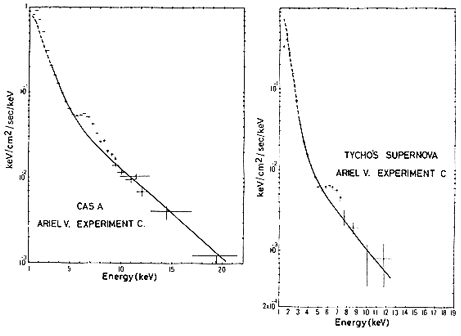Cas A and Tycho's Supernova Remnant X-ray spectraAriel 5 spectra of the young supernova remnants Cas A and Tycho, taken with the Mullard Space Science Laboratory's proportional counter spectrometer. The spectra show that these sources are emitting X-rays from a hot gas. The feature at 6.7 keV is mainly due to the strongest or resonance line of the Fe XXV helium-like ion (the atom has lost all but two of its electrons). The presence of these lines makes it clear that these are thermal sources of X-rays, not synchrotron sources which have flat spectra with no spectral lines. The change in slope at around 5 keV in these spectra was initially thought to arise because of the existence of gas with at least two distinct temperatures. In this model, at ages 300 and 400 years respectively, Cas A and Tycho would have swept up aproximately the same mass from the interstellar medium as was present in the initial stellar ejecta, at which point an additional lower velocity shock wave could propogate through the ejected matter, heating it to a lower temperature than that associated with the primary shock wave. Thus both hot gas populations would emit the Fe XXV spectral line, but silicon lines (not prominent in these Ariel 5 spectra) would be present only in the cooler gas.
Since these data were taken, many new X-ray satellites have flown, much more work has been done in trying to
understand the structure of Cas A and Tycho (both young SNR). New X-ray data
with higher resolution and covering higher energies from satellites such as XTE and ASCA provide better
and more complete data. Still, the debate rages about
a best model of these young remnants. Recent work includes that by
Allen Figure courtesy of Davison, Culhane, and colleagues (MSSL). Reproduced from figure 6-4 in Culhane and Sanford.
IMAGES |
By Mission |
Stars |
HEASARC Home | Observatories | Archive | Calibration | Software | Tools | Students/Teachers/Public Last modified: Thursday, 26-Jun-2003 13:48:44 EDT |


